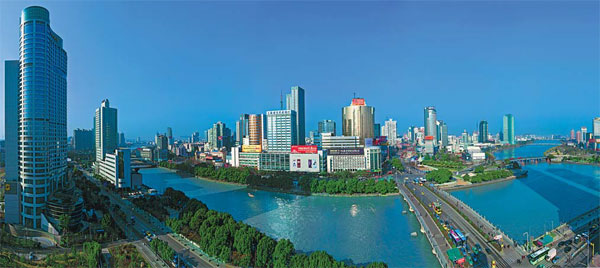Ningbo plans for Belt and Road construction
|
Ningbo, a traditional port city in Zhejiang province, will continue opening up and promoting port cooperation. Photos provided to China Daily |
|
Left: Ningbo hosts the 2014 China-CEEC Ministerial Meeting on Promoting Trade and Economic Cooperation. Middle: The Ningbo-Zhoushan Port is one of the busiest in the world in terms of cargo tonnage. Right: A view of the Hangzhou Bay cross-sea bridge in Ningbo. |
Port city starts forming global links to create economic circle
Ningbo, a traditional port city in Zhejiang province, is taking measures to support China's Belt and Road Initiative.
The Ningbo government has promoted internationalization from March 2014, aiming to face the challenges of economic globalization, deepen its opening up and strengthen the city's global competitiveness.
The authorities said the internationalization process will also strengthen Ningbo's leading role among cities along the Belt and Road. Achievements in Belt and Road construction are also expected to aid the city's internationalization.
Lu Ziyue, mayor of Ningbo, said internationalization will play a fundamental role in helping the city achieve the goals of the 13th Five-Year Plan (2016-2020).
According to Lu, Ningbo will strive to be a first-tier city in the 13th Five-Year Plan period, and a Port Economic Circle will be developed to support its port industry development and construction of the 21st Century Maritime Silk Road.
In January, Ningbo issued an outline to support Belt and Road construction. The outline states that Ningbo will focus on four sectors including cross-border e-commerce, Maritime Silk Road Port Cooperation Organization construction and cultural exchange.
The 610 Action Plan was released along with the outline. The plan states that Ningbo has six main tasks in Belt and Road construction, including promoting port cooperation, economic and trade cooperation, cultural exchanges and cross-border e-commerce.
The Ningbo government plans to initiate 10 projects to support these tasks, with total investment of 142 billion yuan ($22.25 billion).
Multiple approaches
Ningbo has adapted multiple approaches to support construction of the Silk Road Economic Belt and 21st Century Maritime Silk Road.
In the Silk Road Economic Belt construction process, Ningbo will strengthen cooperation with Central and Eastern European countries to expand its overseas connections.
Authorities said the move will deepen communication between Sino-CEE countries to promote cooperation in the energy sector, build Ningbo into a trading gateway between China and Europe and help companies expand their overseas markets, especially in the European Union.
Ningbo aims to be the best investment destination for China and CEE countries, the best trading destination for CEE countries and the best destination for cultural communication to strengthen foreign trade, according to the Ningbo government.
The local government said the Port Economic Circle would be an important part of supporting Ningbo's economic development.
Authorities hope the circle could utilize Ningbo's port resources and develop the city into a strategic highland with strong prospects in international trading, logistics and shipping.
The Ningbo government is encouraging all related parties, including governments and businesses, to work together to develop the Port Economic Circle.
Ningbo has established partnerships with 12 domestic cities, including Xi'an in Shaanxi province and Nanchang in Jiangxi province, to build dry ports to handle cargo locally and speed up customs clearance.
It also built the largest railway freight station serving Shanghai and Jiangsu, Zhejiang and Anhui provinces.
A railway-maritime link that connects Ningbo, the Xinjiang Uygur autonomous region and European countries can save 10 days and 10 percent of logistics costs for companies in East and Northeast Asia.
In addition, Ningbo will support the development of port-related industries to better meet market demand.
It plans to develop logistics chains, commodity trading, shipping insurance, international exhibitions, cross-border trading and e-commerce to strengthen its competitiveness.
Ningbo will continue opening up and promoting port cooperation. The Maritime Silk Road Port Cooperation Organization will be established to strengthen exchanges and communication on prices, route setting and infrastructure construction.
Zhoushan Port and Ningbo Port were merged in September 2015. The Ningbo-Zhoushan Port is one of the busiest in the world in terms of cargo tonnage.
Hub on Belt and Road
Ningbo is a traffic hub that connects the Silk Road Economic Belt and 21st Century Maritime Silk Road.
The Ningbo-Zhoushan Port is one of the busiest ports in China and operates 235 routes to more than 600 ports throughout the world. Throughput of the port ranked third in China and fourth among all ports in the world.
Ningbo has strong economic ties with countries and regions along the Belt and Road.
In the first half of 2015, the Ningbo-Zhoushan Port recorded $33.4 billion in export and import volume between China and CEE countries, accounting for 36.9 percent of the total trading volume of the port.
Ningbo also has solid cultural ties with Belt and Road countries and regions and has sister-city relationships with 45 cities along the proposed route.
China established a pilot program offering preferential policies to cross-border online trading businesses in five cities, including Ningbo, in 2013.
In the past two years, Ningbo's officially run cross-border online trading platform attracted more than 200 companies and traded more than 4,000 foreign products. The platform recorded the largest import volume in China, according to Ningbo authorities.
Companies and institutions in Ningbo are keen on seeking outbound opportunities.
By the end of 2014, Ningbo's businesses and institutions established 2,048 branches in overseas markets.
Local authorities said a majority of the companies that opened foreign branches are privately owned. The Belt and Road countries are new investment destinations for domestic investors.
zhuanti@chinadaily.com.cn
(China Daily 11/23/2015 page10)
















